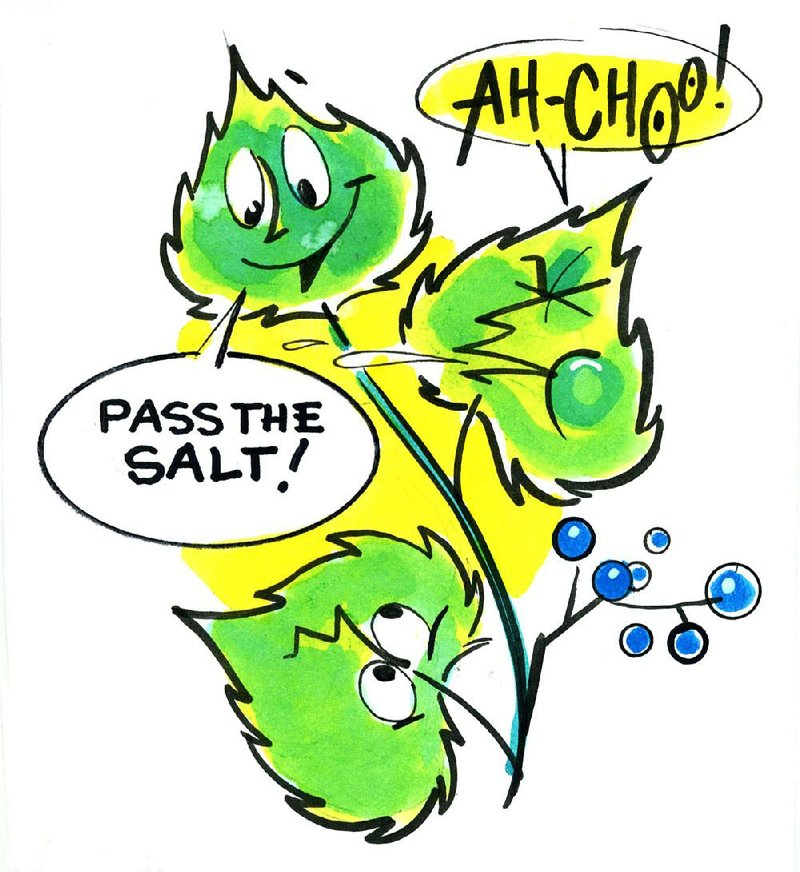Q Can you tell me what kind of vine this is? Poison ivy, box elder or other? Lots in my flower bed.
A The vine is commonly called peppervine -- Ampelopsis is the genus. It can grow quite prolifically. It bears small, purple grape-like fruits.
Q I have a raised flower bed that contains several hundred daffodil bulbs. This bed has been overrun by weeds. Can I spray the weeds with Roundup and not destroy the daffodils?
A The daffodils are still totally dormant, so spraying with Roundup on the surface will not affect them. You would not want to spray if any bulb foliage was present.
Q I have many flowering plants covered by vines with blue flowers. This is the first time I have seen it. Is this kudzu? How do you get rid of it?
A Kudzu is a prolific vine with purple to pink flowers. It is in the pea family, so it has a pea-like bloom. It is a fast-growing vine, so if it is just appearing, do your best to eradicate it. Pull out what you can and then treat the base of the vine with Roundup, if possible.
Q I have a row of cleyera shrubs planted along one side of the house. Now they are huge and I want to move one or two to another spot. Is this possible? When should I attempt it? Any tips to go along with the move?
A The best time to move your cleyera would be November through February -- the dormant season. November is ideal, because you still have some residual soil heat, and the roots can get busy re-establishing before they have to supply food and water to the tops. Try to get the new hole dug before digging up the shrub and protect the roots if the temperatures are low. Water well after replanting and pay attention to the water needs throughout the winter. Winter watering usually is not needed as frequently as summertime watering, but before a hard freeze or cold snap, make sure there is ample moisture around the root zone.
Q I need to ask a question about fall cleanup in my yard, of weeds. We have a great stand of bermuda grass. We have kept up a good fertility program for the past year. Moisture levels are good based on watering and rainfall. We have been regularly mowing, with a good grass height -- not cut too short. I use a mulching mower most of the time and choose not to bag the clippings. I applied fall pre-emergent last week. My question is this: We still have some active crabgrass in front and back. Can I use a "weed and feed" to try and clean up what weeds are still active before they go to seed?
A I cannot imagine that the crabgrass has not already set seeds -- it grows rapidly and produces seed stalks often in-between mowing. I would not use any more fertilizer now, nor post-emergent herbicides for summer weeds. Use a pre-emergent herbicide in late February to early April to prevent the crabgrass seeds from germinating. Your best defense from lawn weeds is a good offense. Having a thick, dense turf keeps weeds at bay. It sounds like you are on the right track.
Q I live in the southeastern corner of the state. My hydrangeas are on the eastern side of a building and were gorgeous this year-- until the large oak tree that provided them with shade had to be cut. They must be moved as they cannot survive another summer like this. Should they be moved in the fall or the spring? Also, Mother-in-law has an azalea that is dead on top and green on the bottom, and I want to move it to our yard as she no longer can care for it. The plant is sentimental to my husband and I would like to do my best to save it. Should I trim out the dead wood before moving and should this be done in fall or spring?
A Since you are in the southern part of the state, you are fairly safe in moving them this fall after they are dormant. For the rest of the state, I typically wait until late February, until the bulk of winter weather is passed. We have had some cold winters that damaged even established hydrangeas, so newly planted or transplanted plants would be more at risk. Same answer for azaleas, except I would do the severe pruning after they bloom in the spring.
Janet B. Carson is a horticulture specialist for the University of Arkansas Cooperative Extension Service. Write to her at 2301 S. University Ave., Little Rock, Ark. 72204 or email her at
jcarson@arkansasonline.com
HomeStyle on 10/01/2016
